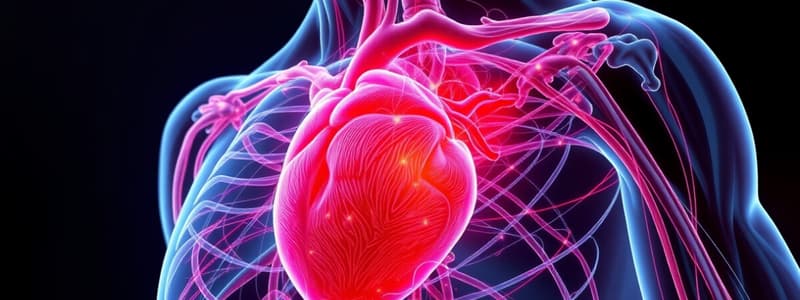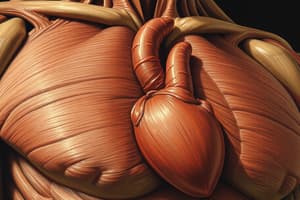Podcast
Questions and Answers
What is the role of junctional folds in muscle cells?
What is the role of junctional folds in muscle cells?
- They facilitate neurotransmitter degradation.
- They provide structural support to the muscle.
- They increase the postsynaptic surface area. (correct)
- They reduce the number of transmembrane receptors.
What is found concentrated near the nucleus in muscle cells?
What is found concentrated near the nucleus in muscle cells?
- Actin filaments and myosin heads.
- Synaptic vesicles containing dopamine.
- Mitochondria and polyribosomes. (correct)
- Neurotransmitter receptors.
How are the borders of smooth muscle cells affected during contraction?
How are the borders of smooth muscle cells affected during contraction?
- They maintain their shape and size.
- They detach from neighboring cells.
- They become elongated and straight.
- They become scalloped and the nucleus distorts. (correct)
What structures do Schwann cells form at the neuromuscular junction?
What structures do Schwann cells form at the neuromuscular junction?
What are caveolae and their association with smooth muscle cells?
What are caveolae and their association with smooth muscle cells?
What role do calcium ions play in muscle contraction?
What role do calcium ions play in muscle contraction?
Which skeletal muscle fiber type is described as having the least resistance to fatigue?
Which skeletal muscle fiber type is described as having the least resistance to fatigue?
What role does acetylcholine play at the motor end plate?
What role does acetylcholine play at the motor end plate?
Which statement accurately describes Type IIa skeletal muscle fibers?
Which statement accurately describes Type IIa skeletal muscle fibers?
Which cellular structure is primarily responsible for inserting into dense bodies to transmit contractile force in smooth muscle?
Which cellular structure is primarily responsible for inserting into dense bodies to transmit contractile force in smooth muscle?
What is the primary composition of thick filaments in muscle fibers?
What is the primary composition of thick filaments in muscle fibers?
What is the sequence of events occurring during the muscle contraction cycle starting from calcium binding?
What is the sequence of events occurring during the muscle contraction cycle starting from calcium binding?
What initiates the muscle impulse at the neuromuscular junction (NMJ)?
What initiates the muscle impulse at the neuromuscular junction (NMJ)?
What prevents smooth muscle fibers from being under voluntary control?
What prevents smooth muscle fibers from being under voluntary control?
How long are the thick filaments in muscle fibers?
How long are the thick filaments in muscle fibers?
Which of the following statements is true regarding Type I skeletal muscle fibers?
Which of the following statements is true regarding Type I skeletal muscle fibers?
Which component is NOT found in the muscle action potential pathway at the motor end plate?
Which component is NOT found in the muscle action potential pathway at the motor end plate?
What structural feature do the heavy chains of myosin share?
What structural feature do the heavy chains of myosin share?
During muscle contraction, what happens to the sarcomeres?
During muscle contraction, what happens to the sarcomeres?
What characterizes the intermediate filaments in smooth muscle cells?
What characterizes the intermediate filaments in smooth muscle cells?
What is indicated by the presence of myosin heads on thick filaments?
What is indicated by the presence of myosin heads on thick filaments?
Which characteristic is unique to Type IIb fibers among the skeletal muscle fiber types?
Which characteristic is unique to Type IIb fibers among the skeletal muscle fiber types?
What is the width of thick filaments?
What is the width of thick filaments?
How does the influx of Na+ affect the sarcolemma upon acetylcholine binding?
How does the influx of Na+ affect the sarcolemma upon acetylcholine binding?
In which region of the sarcomere do thick filaments occupy?
In which region of the sarcomere do thick filaments occupy?
What are dense bodies in smooth muscle functionally similar to?
What are dense bodies in smooth muscle functionally similar to?
Which statement is true regarding the control of smooth muscle contraction?
Which statement is true regarding the control of smooth muscle contraction?
What is the molecular weight of the myosin complex approximately?
What is the molecular weight of the myosin complex approximately?
What activity does the myosin heads exhibit while binding ATP?
What activity does the myosin heads exhibit while binding ATP?
Which type of muscle tissue is characterized by cross-striations and involuntary, rhythmic contractions?
Which type of muscle tissue is characterized by cross-striations and involuntary, rhythmic contractions?
Where is smooth muscle typically found in the human body?
Where is smooth muscle typically found in the human body?
Which of the following statements correctly describes skeletal muscle?
Which of the following statements correctly describes skeletal muscle?
What is the primary feature that distinguishes cardiac muscle from smooth muscle?
What is the primary feature that distinguishes cardiac muscle from smooth muscle?
How do smooth muscles predominantly contract when compared to skeletal muscles?
How do smooth muscles predominantly contract when compared to skeletal muscles?
Which of the following best describes the organization of skeletal muscle tissue?
Which of the following best describes the organization of skeletal muscle tissue?
What role does the sarcoplasmic reticulum play in muscle contraction?
What role does the sarcoplasmic reticulum play in muscle contraction?
Which characteristic is NOT associated with smooth muscle tissue?
Which characteristic is NOT associated with smooth muscle tissue?
Flashcards are hidden until you start studying
Study Notes
Muscle Tissue Overview
- Muscle tissue enables connection and movement of bones.
- Three main types of muscle tissue: cardiac, skeletal, and smooth.
Cardiac Muscle
- Features cross-striations and branched cells.
- Intercalated discs connect cells, allowing synchronous contraction.
- Involuntary and rhythmic contraction.
- Found exclusively in the heart.
Skeletal Muscle
- Organized into elongated muscle fibers.
- Contains a sarcoplasmic reticulum and transverse tubular system for calcium ion transport.
- Contraction mechanism involves cross-bridge cycling of thick (myosin) and thin (actin) filaments.
- Innervated by motor neurons at the neuromuscular junction (NMJ).
Mechanism of Contraction
- Nerve impulses trigger acetylcholine release at NMJ.
- Calcium ions released from the sarcoplasmic reticulum bind to troponin, exposing active sites on actin.
- Myosin heads pivot to pull thin filaments toward the center of the sarcomere.
- ATP powers the detach-and-return cycle, allowing repeated muscle contraction.
Types of Skeletal Muscle Fibers
- Type I: Slow oxidative fibers, maintain contractions over long periods without fatigue, primarily utilize aerobic respiration.
- Type IIa: Fast oxidative-glycolytic fibers, designed for rapid short-term contractions, can switch energy sources.
- Type IIb: Fast glycolytic fibers, primarily use anaerobic glycolysis, fatigue quickly.
Smooth Muscle
- Also known as visceral muscle, lacks striations.
- Contains fusiform cells that contract slowly and involuntarily.
- Present in walls of hollow organs like intestines and blood vessels.
Cell Structure of Smooth Muscle
- Cells exhibit uniform staining with a narrow part adjacent to broader sections of neighboring cells.
- Linked by gap junctions, allowing coordinated contraction.
- Contains organelles like mitochondria, ribosomes, and Golgi apparatus concentrated near the nucleus.
- Includes caveolae, invaginations at the cell surface.
Contracile Mechanism in Smooth Muscle
- Dense bodies anchor intermediate and actin filaments, transmitting force during contraction.
- Smooth muscle operates under autonomic control, influenced by hormones and local factors.
- Lacks distinct motor end plates, instead relying on neurotransmitter diffusion across a synaptic cleft.
Figure: Thick and Thin Filaments
- Thick filaments (1.6 µm long, 15 nm wide) primarily composed of myosin.
- Myosin structure includes heavy chains forming tails and light chains forming heads for ATP binding.
- Cross-bridges formed between myosin heads and actin allow muscle contraction through energy release (actomyosin ATPase activity).
Studying That Suits You
Use AI to generate personalized quizzes and flashcards to suit your learning preferences.



